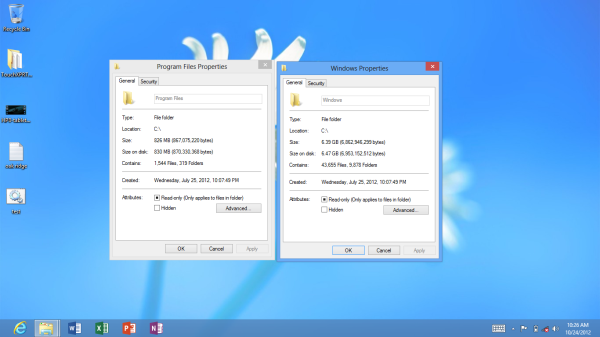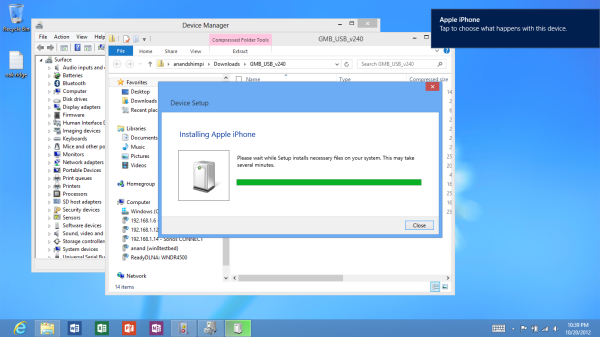The Windows RT Review
by Vivek Gowri & Anand Lal Shimpi on October 25, 2012 12:00 PM EST- Posted in
- Windows RT
- Operating Systems
- Microsoft
- Mobile
- Windows 8
- Tablets
UI Performance, Storage, and USB Compatibility
by Vivek Gowri and Anand Shimpi
With Windows Phone 7, Microsoft did a great job of taking generation-old hardware and delivering a great user experience in spite of any silicon-level deficiencies. So naturally, with the new Windows UI, we were expecting a very smooth UI regardless of the underlying hardware. And they’ve most certainly delivered on that.
Animation frame rates are consistently good all the way through the UI, easily delivering what appears to be 60 fps for UI transitions. When pushed, Modern UI seems more likely to completely drop animations versus dropping frames, which eliminates the choppy experience you sometimes find in Android. It isn’t a common occurrence, the experience is generally very fluid. This kind of consistently smooth UI is what Google has been striving for in every recent release of Android, dedicating the release of 4.1 to eliminate the dropping of frames in even basic interactions. Scrolling, swiping, snapping, app switching - it doesn’t really matter what you’re doing, RT is just really smooth. Combined with the fluidity of the gestures, the entire system just feels like liquid, there are just no real slowdowns even running on a no-longer impressive SoC like Tegra 3.
| Application Launch Time Comparison | |||||||
| Boot | Web Browser | Maps | Games Center / Xbox | ||||
| Apple iPad (3rd gen) | 32.0s | 1.0s | 2.4s | 1.1s | 1.9s | ||
| Microsoft Surface | 27.7s | 2.6s | 7.1s | 5.0s | 5.0s | ||
But there is one area that RT struggles in, and it’s something that was an issue in Windows Phone 7 too - application launch times. Anand included this table in his Surface review, and it shows that boot performance is decent, but the 3rd generation iPad just kills it in application loading. The new A6X-infused 4th gen iPad probably widens that gap too, so it’s a pretty stark difference. It’s something that Microsoft needs to really focus on when updating the OS, because it’s easily one of the most glaring flaws in an otherwise stellar interface.
From a storage standpoint, the OS takes up between 6.5 and 7.5GB of space (Anand measured 6.47GB on Surface, I measured 7.35GB on the VivoTab RT) and Office takes up another 750-850MB (830MB for Surface, 749MB for the ASUS), so you’re looking at 7.5-8GB of NAND dedicated to the OS. On my 32GB VivoTab RT, I had 25.3GB of storage to start with, so after Windows and Office, I was looking at 17GB left over for programs and documents. That’s....not a lot - a bit of music, a decent selection of applications, a couple of videos, and pretty soon I’m looking at less than 10GB of storage left over. Thankfully, we’re seeing microSD slots on a lot of the more prominent Windows RT slates, so if you run out of room, you could theoretically toss in a 32GB or 64GB microSDXC card. Depending on how much data you plan on storing, I think you can get away with the lesser internal NAND and some microSD cards.
It’s also pretty clear that there will not be a Windows RT slate shipped with less than 32GB of onboard NAND. If you’re holding out for a cheaper Windows RT device with less storage, like a 16GB tablet for $399, there’s almost no way that happens - it’s implausible to think that anyone would ship a tablet with less than 5GB of space left for data storage.
Another key detail in Windows RT is wide-ranging USB peripheral support. USB ports have been a common feature on 10” Android tablets, but device support was typically limited to flash drives and basic input devices. The goal with Windows RT was to bring the traditional Windows experience to tablets, so USB driver support is pretty important. It’s not as easy as on an x86 system, where most USB peripherals would just work, but even with more limited Windows-on-ARM drivers, it’s pretty decent overall.
USB drives obviously work as you’d expect them to. Even SATA to USB adapters worked fine when plugged into Surface. Other smartphones and tablets also worked, although their level of support varied. For example, you can plug in the iPhone 5 and have it come up as a supported device for moving pictures to/from. However USB tethering is not supported by the class driver included in Windows RT. You can even plug an iPad into Surface and get the same level of support. The few Android phones I tried to connect in MTP all worked as expected, though transfer rates off my Optimus 4X HD seemed on the slow side, likely a function of the phone’s internal eMMC.
Printer support is pretty decent, although the Epson Workforce 910 Anand tried didn’t actually have specific driver support under RT. Although development for the desktop side of Windows is limited, manufacturers can supply Windows RT drivers to enable support for some more obscure devices. Unfortunately when it comes to those devices you’ll have to play the waiting game as there’s simply not a lot of third party Windows RT drivers available for download today.












233 Comments
View All Comments
Sivar - Thursday, October 25, 2012 - link
Vivek and Anand, did you experience the problems described by guidryp?cappasay - Thursday, October 25, 2012 - link
I may be wrong but from what I understand, all the crashes are about third-party apps forcefully closing down. Not native apps, and not a full system crash or anything like that. Presumably that will get better over time, as devs actually learn the platform (updates are getting pushed out daily). Slowdowns seem to have occurred in other videos, only you have a bunch of apps open at the same time.daboochmeister - Thursday, October 25, 2012 - link
Not according to other reviews. E.g. Matt Burns at TechCrunch, whose review reads as completely honest and informed, found crashes in the Metro^h^h^h^hodern apps, at least once per app, including MS's. And he found the new IE10 to be less than great.http://techcrunch.com/2012/10/23/microsoft-surface...
Other reviews have said much the same.
The more high-profile the site, the more likely they are to give it a positive review. Hmm ...
VivekGowri - Thursday, October 25, 2012 - link
For the record, I had exactly one random shutdown, and that was when I was switching between two different camera applications at the same time. It seemed forgivable, and other than that I legitimately had no major bugs/crashes when I was testing. My VivoTab RT was really solid from a software standpoint, I don't know what to tell you guys.daboochmeister - Thursday, October 25, 2012 - link
Hmm. Maybe the Surface RT then. Different hardware.PeteH - Thursday, October 25, 2012 - link
Just because some people run into bugs it doesn't mean everyone will.p05esto - Thursday, October 25, 2012 - link
Lame response. Have you personally found all of these bugs and problems you are posting about? Do you have a Windows tablet in your hands? Just curious. In other words you are a fool, lol.TEAMSWITCHER - Thursday, October 25, 2012 - link
I too, am finding myself a bit suspicious of these reviews. I just cant get excited about Windows 8...in any form. There is something about it that disgusts me. Let me try to explain......Windows 8 was not designed to solve problems for me. It was designed to solve problems for Microsoft - namely competing against Apple mobile devices and Google's web services. The only major new functionality is a UI that can driven by a touch screen - (Compete with Apple) and the new Start Screen which is huge billboard directing witless users to Microsoft Web services (Compete with Google.) What does Windows 8 do for me, the guy who runs Windows 7 on a single 27" monitor with a Mouse and Keyboard?
Many people have told me that the tiles will be great. Really? I think that Gadgets are better, as I don't need to leave my desktop for a simple status update! That Metro apps will be great - you can run two apps side-by-side. I can run many apps side-by-side in Windows 7. I have read that touch screen laptops will transform the Windows experience. Not for me, I don't want to look through a hundred finger smudges to see my work.
The UI is definitely NOT gorgeous! The overuse of inky pastel colors makes me cringe every time I look at it. The removal of glass Windows and drop shadows make the desktop look old, flat, and boring. Please don't give me the "Simple and Elegant" argument - its not that!
I fear that all my ranting is for naught. No matter what I say, type, or do it won't matter. Windows 8 will be a resounding success because there is simply nothing else the PC OEMs have to sell. Microsoft will no doubt take the stage at this fall's BUILD conference and proclaim that they were right.
Sadly for me I cannot agree. Windows 8 is where I and Microsoft part ways...forever! I'd like to think that the break up was amiable, but that's not what happened.
Microsoft tried to F@#K me!
steven75 - Friday, November 2, 2012 - link
It's also almost like Vivek is completely unaware of the iWork suite that came out with the iPad back in 2010. And it's completely touch-optimized, not just a ported hack from OS X.code65536 - Thursday, October 25, 2012 - link
So how exactly is this no-third-party-desktop-apps thing enforced? Are they simply relying on the fact that people haven't recompiled EXEs from Intel to ARM (no enforcement)? Are they restricting the availability of the compiler (but they need a native compiler for folks like driver developers)? Are they whitelisting EXEs? Or must EXEs have a certain digital signature before they are allowed to run?